
 Copyright 2013, 2010, 2007 by Barrons Educational Series, Inc. Copyright 2004, 2001 by Barrons Educational Series, Inc., under the title Hot Words for the SAT I. All rights reserved. No part of this book may be reproduced in any form or by any means, or incorporated into any information retrieval system, electronic or mechanical, without the written permission of the copyright owner. All inquiries should be addressed to: Barrons Educational Series, Inc. 250 Wireless Boulevard Hauppauge, New York 11788 www.barronseduc.com eISBN: 978-1-4380-9213-3 First eBook publication: July, 2013 Dedicated to my beloved Sandro & precious sons Phillip, Andrew, & Luca who inspire me daily
Copyright 2013, 2010, 2007 by Barrons Educational Series, Inc. Copyright 2004, 2001 by Barrons Educational Series, Inc., under the title Hot Words for the SAT I. All rights reserved. No part of this book may be reproduced in any form or by any means, or incorporated into any information retrieval system, electronic or mechanical, without the written permission of the copyright owner. All inquiries should be addressed to: Barrons Educational Series, Inc. 250 Wireless Boulevard Hauppauge, New York 11788 www.barronseduc.com eISBN: 978-1-4380-9213-3 First eBook publication: July, 2013 Dedicated to my beloved Sandro & precious sons Phillip, Andrew, & Luca who inspire me daily
my supportive family, friends, colleagues at Cold Spring Harbor Schools, my wonderful students
and
my cherished parents Anne & Ernest ACKNOWLEDGMENTS With love and gratitude to my husband and children, my inspirations. To my husband, who encouraged me every step of the way in this process, through late nights of writing, and who helped me find my way through myriad PC file management debacles.
With love to my parents, Anne and Ernest, whosince I was a preschoolerencouraged me to write, and to dream the impossible dream. Great thanks to my dedicated editor, Linda Turner, to Wayne Barr, who first welcomed me to Barrons, and to George Ehrenhaft for his contribution to this book. This eBook contains hyperlinks that allow you to click between all questions and answers for practice and review. Contents Introduction Are you ready for the HOTTEST of the HOT WORDS? This book is divided into 39 lessons, 37 containing more than 365 SAT-level words that have been taken off of Barrons high-frequency database of words and off of recent SAT tests. Additional SAT words are featured in the exercises. Why is this edition particularly HOT? This edition contains a phonetic pronunciation guide for every word.
Vocabulary-in-context paragraphs appear after each set of five lessons, illustrating how the SAT words can be used in descriptive prose. References have been updated and several definitions have been elaborated upon. The innovative format of this book sets it apart from other vocabulary books. Word Clustering is especially effective in learning hundreds of vocabulary words. Unlike dictionary-style, alphabetized lists, clustering groups Hot Words with similar meanings so that distinctions in usage and connotation can become more apparent. Never before presented so comprehensively in an SAT preparatory book, clustering boosts vocabulary building exponentially! New to this edition: ACT vocabulary There are four reading passages that make up the ACT Reading Test.
The four passages come in four genres: Prose Fiction, Humanities, Social Science, and Natural Science. To clearly and thoroughly absorb the information in these expository passages, it is beneficial for test takers to have a strong vocabulary. Knowing more sophisticated words will allow test takers greater clarity about what they are reading and, in turn, allow them to answer questions more accurately. This edition of Hot Words includes two new ACT vocabulary lessons. The first lesson contains words appearing in the Prose Fiction and Humanities passages; the second lesson, the Social and Natural Sciences passages. In fact, these words all appear in The Real ACT Prep Guide , 3rd Edition, which is published by the ACT test makers themselves.
Vocabulary in your life Vocabulary is still imperative and vital to doing well on the three critical reading sections of the SAT. Testing aside, gaining a broad and rich vocabulary edifies your life skills and people skills. The paragraphs that follow illustrate ways in which vocabulary can enrich your everyday life. Future prep If you apply to graduate school one day, the words you learn now will help you later on the verbal portions of grad school admissions exams, like the LSAT, MCAT, or GRE. Reinforcement through writing Next time you write an essay or creative piece for school, try to use some of your new words in your writing. If you have to submit a project on poster board or PowerPoint slides, include upper-level vocabulary words as you write out the text for this visual presentation.
Use upper-level vocabulary in your e-mails and blogs. Reinforcement through speaking Be mindful when you participate in class or speak up at an after-school club or activity. Also be mindful when you speak to your parents, neighbors, or employer. Can you use new vocabulary words to get your points across more effectively as you engage in everyday conversations? Lively letters Next time you write a letter or thank-you note to Aunt Anne or Grandma Rose, include one or two of your new words in your message. Maybe youll get a handwritten note backmore fun than getting a shorthand e-mail! Zesty dinner talk Sprinkle a couple of new words in your dinner conversation tonight. Did your teacher lavish you with high praise and an A+ ? Did the guest speaker at school refer to you as astute? Was your soccer teams spirit bolstered by a 91 win against the formidable Pythons? Go ahead and sprinkle those words you might be offered a second helping of dessert! What is exponential vocabulary growth? Unlike linear growth, which involves a constant addend (+5 in this case)5-10-15-20-25-30exponential (or geometric) growth is rapid (5 in this case)5-25-125-625-3,125.
As you can see, exponential sums far exceed linear sums. Linear vocabulary building involves learning one isolated, alphabetized word at a time. Exponential vocabulary building involves dynamically associated clusters of words. Consider this visual analogy: Linear vocabulary growth is like a tall stalk of bamboo, adding one foot of bamboo (or one word) at a time. Exponential vocabulary growth is like a massive oak tree, adding whole branches of words at a time. The majority of lessons in this book are cluster-formatted so that you can expeditiously learn groups of words at the same time.
As you work through each cluster lesson, read the definitions and illustrative sentences carefully. Challenge yourself to learn the nuance or shade of meaning for each individual word in the lesson. Why cluster vocabulary words? There are many reasons. Clustering is based on an educational-psychological idea called apperception. Apperception, according to Merriam-Webster OnLine, is rooted in the process of understanding something perceived in terms of previous experience (knowledge). So, for example, if you know that trite and banal mean unoriginal, link this old knowledge to new words like platitude, hackneyed, and clich.
Moreover, instead of regarding platitude, hackneyed, and clich as isolated, unattached elements (as youd encounter them in an A-B-C order list), think of this trio of words as linked to the same category that already contains trite and banal . Furthermore, apperception is perception that reflects upon itselfsometimes intensified or energetic (Merriam-Webster OnLine). Clustering in this manner keeps you immersed in SATtype vocabulary, bringing your vocabulary growth to a new level. Consider this analogy: Just as teachers of French or Spanish find immersion-style lessons effective, I find SATvocabulary immersion effective for me and for my students. Immerse yourself in SAT vocabulary. I hope that hearing a particular vocabulary word will bring to mind a bevya plethoraof associated words.
In each lesson of Hot Words, a connection exists among the words; the words relate to each other in some way. As a verbal SAT tutor, I have seen firsthand how this kind of vocabulary dynamic is highly effective for many of my students. When alphabetized lists are used, confusion and frustration sometimes occur for students becauseas you can seethe words may start off in similar ways:
Next page
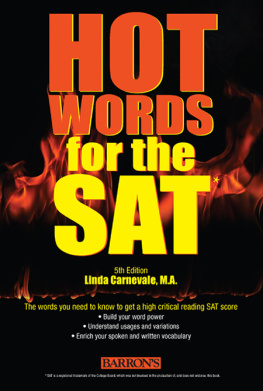
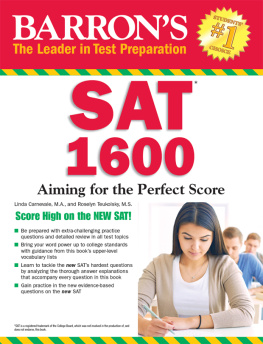
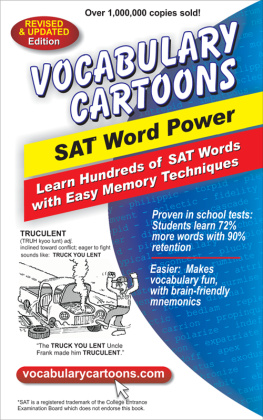

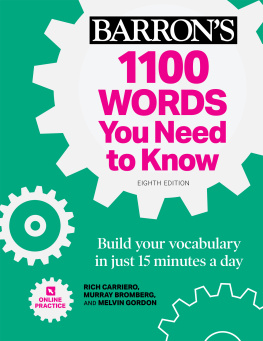
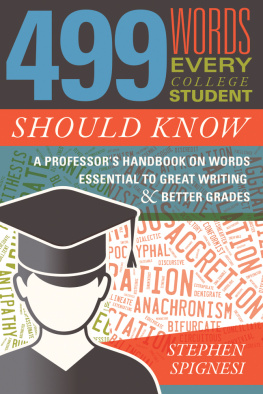

 Copyright 2013, 2010, 2007 by Barrons Educational Series, Inc. Copyright 2004, 2001 by Barrons Educational Series, Inc., under the title Hot Words for the SAT I. All rights reserved. No part of this book may be reproduced in any form or by any means, or incorporated into any information retrieval system, electronic or mechanical, without the written permission of the copyright owner. All inquiries should be addressed to: Barrons Educational Series, Inc. 250 Wireless Boulevard Hauppauge, New York 11788 www.barronseduc.com eISBN: 978-1-4380-9213-3 First eBook publication: July, 2013 Dedicated to my beloved Sandro & precious sons Phillip, Andrew, & Luca who inspire me daily
Copyright 2013, 2010, 2007 by Barrons Educational Series, Inc. Copyright 2004, 2001 by Barrons Educational Series, Inc., under the title Hot Words for the SAT I. All rights reserved. No part of this book may be reproduced in any form or by any means, or incorporated into any information retrieval system, electronic or mechanical, without the written permission of the copyright owner. All inquiries should be addressed to: Barrons Educational Series, Inc. 250 Wireless Boulevard Hauppauge, New York 11788 www.barronseduc.com eISBN: 978-1-4380-9213-3 First eBook publication: July, 2013 Dedicated to my beloved Sandro & precious sons Phillip, Andrew, & Luca who inspire me daily